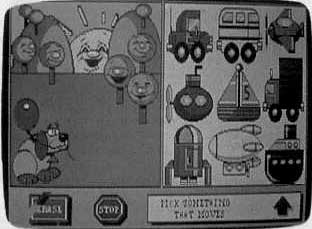THE PUZZLE STORYBOOK
Zug, that lovable, huggable monster, is back in First Byte's The Puzzle Story-book. This time, he's here to teach kids about shapes, encourage them to write stories, and tempt him to do puzzles.
The Puzzle Story-book is designed to appeal to children between ages 3 and 8. The graphics are bold, the colors are bright, and the menus use a combination of words and pictures to make it easy for even nonreaders to understand how to get around the program.
Kids can choose from three activities: Picture, Puzzle, and Story. The Picture option lets children create a series of storybook pictures. They can add a background, a person, a moving object, and a building to each scene. They can print the picture or use the Keep option to save the picture in the library on the program disk.
The Puzzle Game is actually two different games, Shapes and Tiles. The Shapes Puzzle asks you to identify six basic shapes: oval, circle, triangle, parallelogram, rectangle, and square. The Tiles Puzzle divides the picture into large blocks which are shuffled onscreen. The goal is to unscramble the image one piece at a time, trying not to make any mistakes.
My favorite part of Puzzle Storybook is the Story activity. Start by creating a new picture or choosing one from the library. The right side of the screen then changes into a talking word processor. Depending on the settings selected in the Helper Control Panel, the computer reads back your youngster's work either letter by letter, word by word, or sentence by sentence. By selecting the Radio icon, you can hear the whole story read repeatedly, either for enjoyment or to make corrections with the phonic clues provided.
When you finish a story, you can add it to the library, print it out for bedtime enjoyment, or have the computer read it out loud just for the fun of hearing it talk.
The speech quality in the Puzzle Storybook is excellent. In addition to the speech generator, there is a phonic dictionary of frequently used words and an editor to make manual corrections to special words, such as the names of friends and pets. Attentive youngsters will quickly learn how to correct their work independently, just by listening for words that don't sound quite right.

The program does have some frustrating features. Even with all the images supplied with the program, the pictures you create quickly begin to look very similar. To add to the irritation, pieces can only be put in preset locations, which severely limits story-creation possibilities. Printing routines are similarly limited; pictures and stories can be printed in only one size, and it's impossible to predict how the page layout will come out.
While all the youngsters I let work with the program loved creating pictures and writing stories, the Puzzle section was less well received. Neither the Tiles game nor the Shapes game keeps records, and Zug's reaction is independent of the effort required in both games. Additional challenge in this section would have definitely improved the program.
Overall, The Puzzle Storybook succeeds with children because it appeals to their sense of fun, and it works well because the choices make sense to them.
LESLIE EISER
|
Amiga—$39.95 IBM PC and compatibles with 512K—$39.95 (Covox Speech Thing or Tandy 1000 sound chip needed for voice on PC) Macintosh—$39.95 FIRST BYTE 3100 S. Harbor Blvd. Suite 150 Santa Ana. CA 92704 (800) 523-5070 (714)432-1740 |